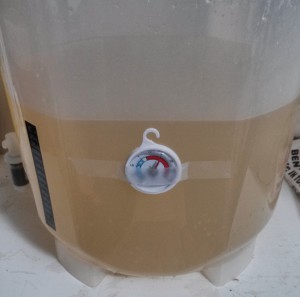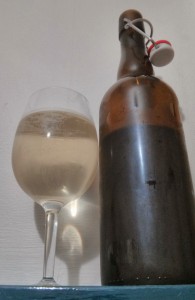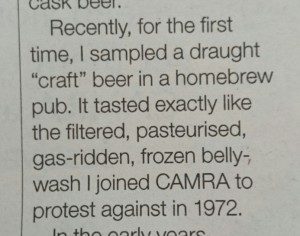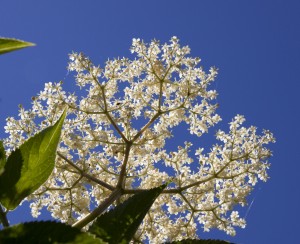This is a log of the production of my first ever “Elderflower Fizz“. Every year I know when elderflower season has hit because I get terrible hayfever as soon as they’re flowering – although it doesn’t seem to be the elderflowers themselves causing the problem but something else producing pollen at the same time (current suspicion is barley). We’ve used elderflowers in jellies before and I love the flavour and have long wished to do something more with them – always to find the flowering is over before I get a chance. This year I was determined to brew up an elderflower “fizz” – and I did… I read many “recipes” online as research, quite a few of them were downright scary. Paraphrasing massively: “mix it all together in a bucket, leave it 4 days, bottle it up, make sure you release pressure every few days”. Bottle bombs! :-| I have taken a more beery and scientific approach… here’s how it was done:

Deflowered
Day 1 – frolic in the meadows and along the hedgerows:
It’s the 30th of June – a beaut warm sunny day, so we go for a walk away from the roads and collect 60 elderflower heads. When we get home we deflower them – a slightly tedious process using fingers and forks, but it considered best to minimise the amount of “stem” in the mix. We achieve a yield of about 165g of flowers from our 60 umbels. The flowers are placed in a clean plastic container, 2 litres of boiling water is poured over, and a tablespoon of lemon juice added to reduce discolouration. This mix is covered, left to cool, then popped into the fridge for 4 days to steep.
Day 3 – make saison yeast starter:
In the early AM: Make 1 litre of 1040 yeast starter using 105g of cane sugar and add a vial of Saison II from White Labs. I picked this yeast for two reasons: first is it was simply what I had to hand – recently bought for a planned beer brew; second I thought a “funky” yeast would be good to add a bit of extra flavour to something fermented simply from sugar.
Day 4 – early morning – cool saison yeast starter:
Place yeast starter in fridge to encourage yeasties to settle to the bottom. (It turned out to have dropped to 1030 in about 18 hours and the amount of yeast had built up nicely.)
Day 4 – evening – put it all together:
Decant clear liquid from the yeast starter to sterilised container and cover. Refill the original yeast vial (sterilised) with yeast sediment for later re-use – this is purely so I have some Saison II to culture up for a subsequent beer brew. Rinse the rest of the yeast sediment into the decanted starter liquid. Cover and leave aside to come to to room temperature.
Heat 2 litres of water with 2.3kg of sugar and the rind of 2 lemons until simmering. Simmer for 20 minutes. Strain in fresh juice of 4 lemons and the elderflower liquid, rinse flower pulp with 2 litres of water, then with clean hands squeeze out all the liquid you can. Cover this mixture and let cool to about 30ºC. [I believe I should have used less lemon juice, but many others who’ve tasted the fizz seem happy with the acidity – it has a bite reminds me of rather grim Western Australian Chardonnay.]

Fermentation Vessel
When cooled pour the liquid through a sterile sieve into a sterile fermentation bin. I did this from a good height to help introduce some oxygen. Top up to 15 litres with clean, preferably well aerated, water. Wait for temperature to drop to about 20ºC before pitching in yeast.
Original gravity: 1074
Let this sit in a suitable spot to ferment away, my fermentation happened in a range of about 20ºC to 24ºC.
Day 9 – early morning – prepare champagne yeast addition:
At day 9 I’ve noticed that the gravity hasn’t shifted much over the last two days so it is time for the next stage. I’ve chosen to add a champagne yeast to chow through any remaining sugar to yield a “dry” end product. Create a 1040 gravity yeast starter as per day 3 and into this pitch a sachet of champagne yeast.
Day 10 – evening – champagne yeast addition:
At this point the mixture has had 6 days fermentation time.
Stable gravity with Saison II: 1042 (~4.2%)
Pitch in whole 1 litre champagne yeast starter and take a gravity reading so we can calculate the ABV yielded from the next stage of fermentation.
Champagne yeast OG: 1040 (watered down slightly by starter)
Day 15 – a status update:
Gravity check, now 1017 so approximately 7.2%. Has gone very cloudy now – hopefully a sign the yeast is still eager, would like this to come out quite dry.

Final Gravity
Day 24 – prepare for bottling:
The gravity is stable and very low now – it is time to bottle!
Final Gravity: 0998 – wowzers – beastly yeasties!
This means we have about another 5.5% ABV from the champagne stage, giving a strength of approximately 9.7% before bottling.
Siphon, or otherwise move, the liquid into another vessel (anything suitable for bottling from, a pressure barrel is what I had handy). The aim is to leave all the trub behind. The de-trubbed liquid is then refrigerated overnight to encourage even more yeast to drop out. Note: weight of the liquid is 15.3kg – assuming approx 1kg = 1 litre this lets me calculate how many bottles to get ready.

Bottled Elderflower Fizz
Day 25 – bottling day:
To the pressure barrel add 190g of brewer’s sugar melted in 200g of warm water for priming. The aim is for just under 4 vols C02 – a robust “fizz”. Stir gently and then bottle it! Now a waiting game begins…
RESULT!
A good fizz had built up after a couple of weeks and since then it has been tried by a few friends of ours as well as ourselves. (We tested it on ourselves well in advance to ensure it wasn’t poison!) Everyone seems to like it a bit better than I do, including Kat. I find it a bit too sharp for my tastes – and would aim to add half as much lemon juice next time perhaps. However several other independent opinions are positive – or maybe they’re just being nice ;)
My own tasting notes, made on October 3rd – about 2 months after bottling:

Glass of elderflower fizz
- Eyes:
- Colour is a pale straw, almost crystal clear.
- Constant bubble streams rise through the glass.
- Nose:
- Yep, distinctively elderflower – not overt, but distinct.
- There is a saison “farmy” note too – not sure you’d pick it without knowing to expect it.
- Too much of a “boozy” note, à la sniffing a bottle of meths.
- Mouth:
- First to hit is sensation rather than taste: fizz prickle, lively carbonation.
- Flavour is perfumed, kind of soapy really.
- Sharpness akin to a rather astringent Chardonnay.
- This is backed by a “woody” spice which almost makes up for missing body.
Thoughts: it needs less “meths” aroma and maybe rather than less sharpness it needs more body – a source of tannic acid perhaps? Something like that to balance it out. The saison yeast has helped here – I think with just champagne yeast it would have been really harsh on the tongue and nose.
Well – despite some misgivings I consider my first attempt at a “country wine” style of thing to be a success. Next year perhaps a couple of tweaks… cheers!
Elderflower Saison Fizz from Yvan Seth on Vimeo.






